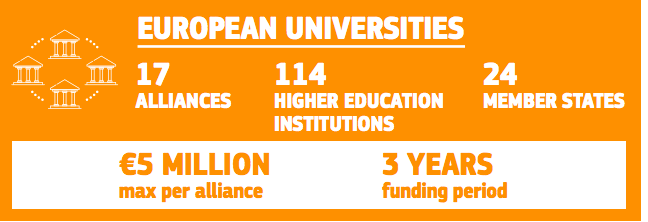In a move making the European Education Area a step closer, the first 17 networks of institutions to form “inter-university campuses” across the EU and become part of the European Universities alliances have been announced by the European Commission.
News and business analysis for Professionals in International Education
Have some pie!
First “European Universities” networks announced
 Each of the 17 European University is composed of seven institutions on average. Image: European Commission
Each of the 17 European University is composed of seven institutions on average. Image: European Commission This is the result of the first pilot call for the establishment of transnational networks of universities across Europe, with a second one to be launched this autumn.
“I am convinced that this initiative… will be a real game changer for higher education in Europe”
The 17 groups, selected from 54 applications, account for 114 higher education institutions spanning EU 24 member states and will each receive up to €5m in funding over the next three years to build their collaboration. Each European University is composed on average by seven institutions.
“I am pleased to see the ambition of the first 17 European Universities, which will act as role models for others across the EU. They will enable the next generations of students to experience Europe by studying in different countries,” Tibor Navracsics, Commissioner for Education, Culture, Youth and Sport, said in a statement.
“I am convinced that this initiative, a key building block of the European Education Area, will be a real game changer for higher education in Europe, boosting excellence and inclusion.”
European Universities will act as “inter-university campuses,” the Commission explained in a statement, pooling expertise, platforms and resources and allowing students and staff to move seamlessly. These networks are also called to contribute to the sustainable economic development of the regions where they are located
While some alliances cover all disciplines, others have a specific focus on urban coastal sustainability, social sciences or global health.
The initiative, part of the push towards establishing a European Education Area by 2025, was first proposed by the European Commission to EU leaders in November 2017.
Pleased to support these first 17 #EuropeanUniversities with €85 million over 3 years. We will develop this initiative based on their experiences, the results
of a second test to be launched in autumn 2019 & full roll-out under future#Erasmus programme https://t.co/nHJ69cfsKy pic.twitter.com/aAP7wD0ybn— Tibor Navracsics (@TNavracsicsEU) June 26, 2019
Funded under Erasmus+, the call for applications originally received responses from 54 networks incorporating more than 300 institutions. The original €60m allocated for the call funding 12 networks have been increased to €85m, which has enabled 17 networks to be selected.
The European University Association was involved in the process from the beginning and part Stakeholder Consultation Group established by the Commission to carry out the initiative.
Its president Michael Murphy, during the Bologna Process 20th Anniversary conference in June, spoke in support of transnational networks, which he said would simplify the attainment of the traditional Bologna Process goals.
“Networks will require new transnational academic governance models, new funding arrangements and challenging institutional cultural changes,” he said
“This is a big political challenge, one first likely addressed within the EU, but where the EHEA will play a key role in including the whole of Europe in its ultimate design.”
In a statement, EUA said it will continue to advocate for the development of a European Education Area to be aligned with existing frameworks such as the Bologna Process and the European Research Area.
“In European integration of higher education and research, there are several formally distinct processes,” Michael Gaebel, EUA director of Higher Education Policy, told The PIE News, referring for example to the Bologna Process, the European Research Area, Horizon 2020, ET2020, and the European Education Area.
“Evidently, these processes overlap in participation, purpose, and content, but while they may deviate in strategy, priorities and means, overall, we see them as highly complementary and synergetic. And, we have to make sure that this is maintained and further enhanced.”
A list of all the 17 networks with their member institutions can be downloaded here.
Still looking? Find by category:


